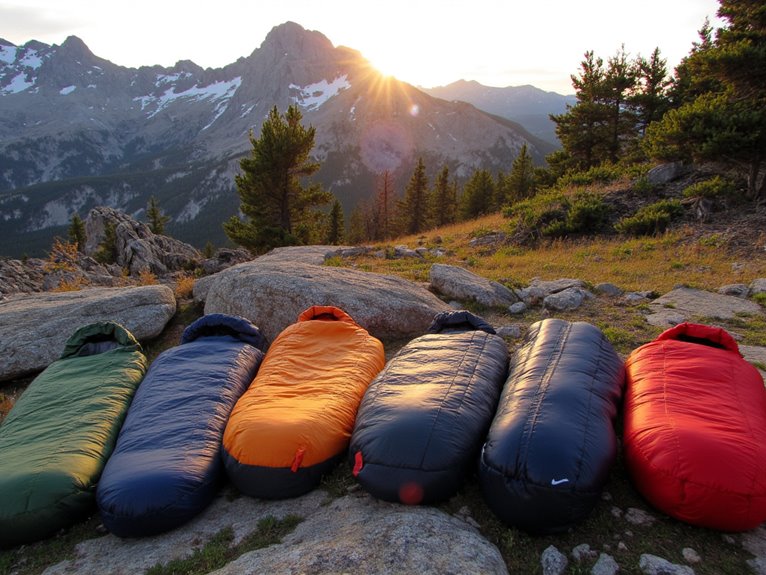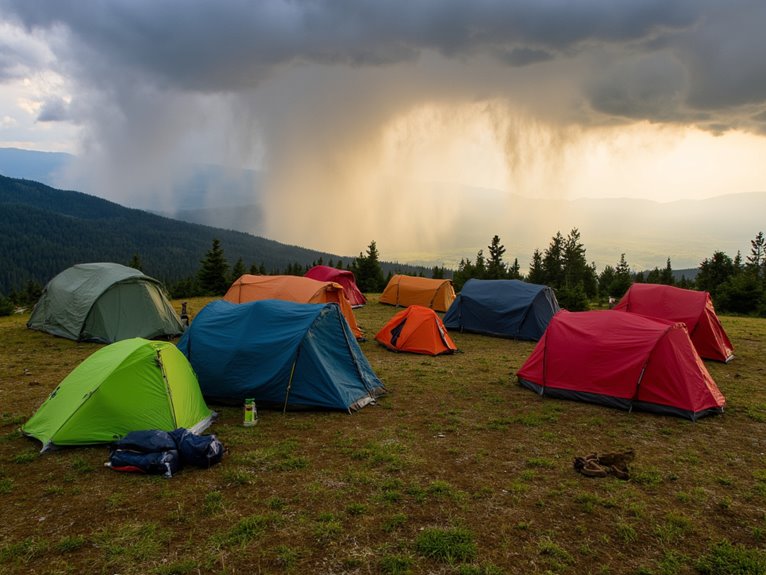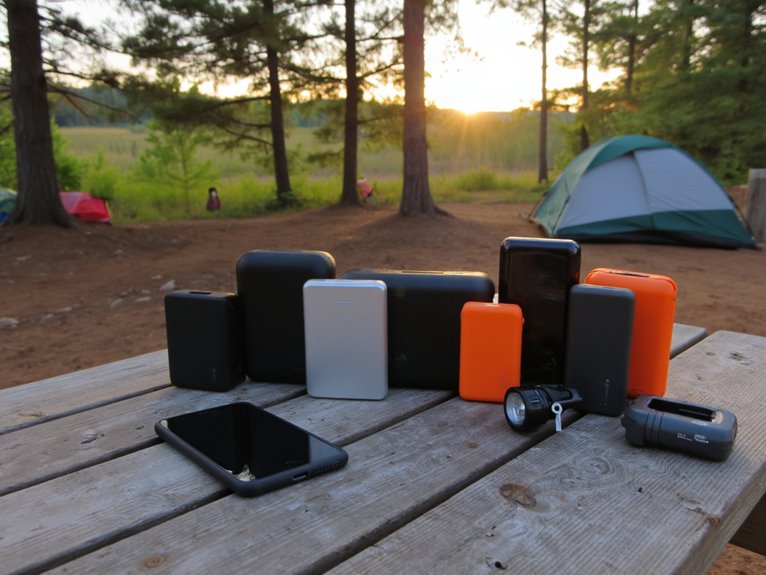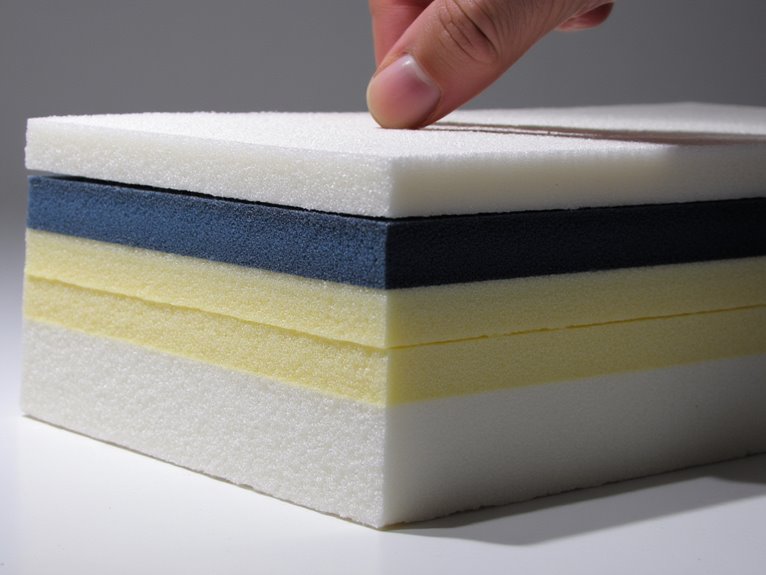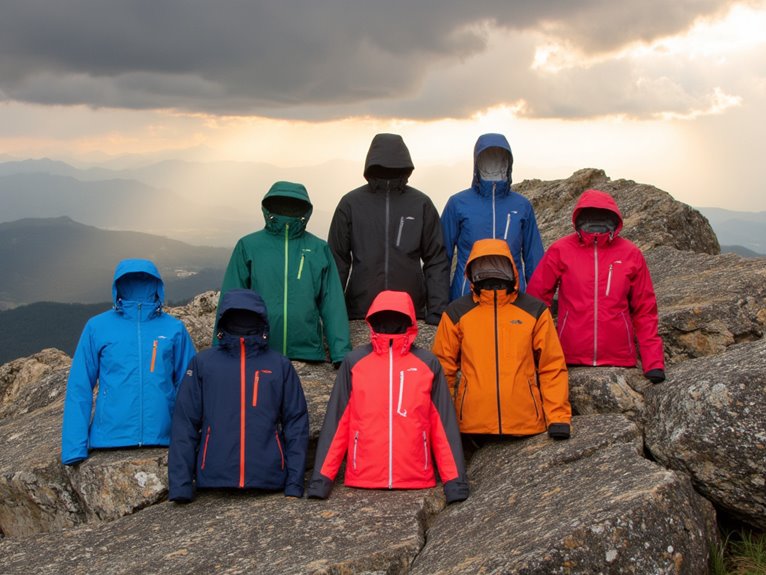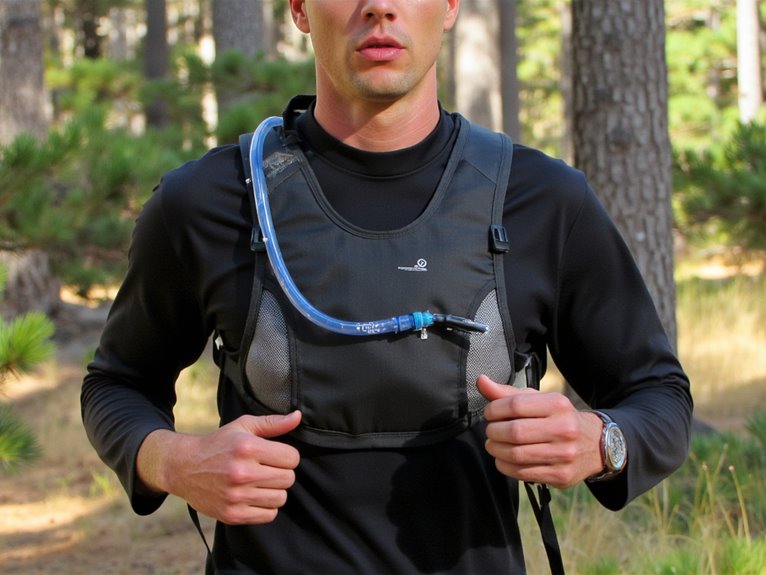10 Best Ultralight Backpacking Sleeping Bags for Your Next Adventure
I’ve tested countless ultralight sleeping bags, and the top performers weigh between 1.5-3.2 pounds while delivering exceptional warmth-to-weight ratios. The QEZER Down Sleeping Bag leads at just 1.54 pounds with 600 fill power down, compressing to 10.6×5.5 inches for temperatures above 45°F. The 620FP model offers superior RDS-certified down at 1.72 pounds, handling 35-60°F conditions. These bags compress to half the size of synthetic alternatives while maintaining durability through 400T 20D nylon shells. Below, you’ll discover detailed specifications that transform your gear selection process.
We are supported by our audience. When you purchase through links on our site, we may earn an affiliate commission, at no extra cost for you. Learn more. Last update on 25th December 2025 / Images from Amazon Product Advertising API.
Notable Insights
- Ultralight sleeping bags should weigh between 1.5-3.3 pounds and compress to dimensions like 10×5.5 inches for optimal portability.
- Down insulation offers superior warmth-to-weight ratios, with 600+ fill power providing excellent thermal efficiency for backpacking.
- Temperature ratings vary significantly: some bags suit warm weather (50-85°F) while others handle colder conditions down to 18°F.
- Durable materials like 400T 20D nylon shells provide tear resistance, windproofing, and moisture protection for outdoor adventures.
- Three-season versatility and dual-function designs allow bags to serve as both sleeping bags and blankets for various camping scenarios.
Down Sleeping Bag for Adults, 600 Fill Power with Compression Sack
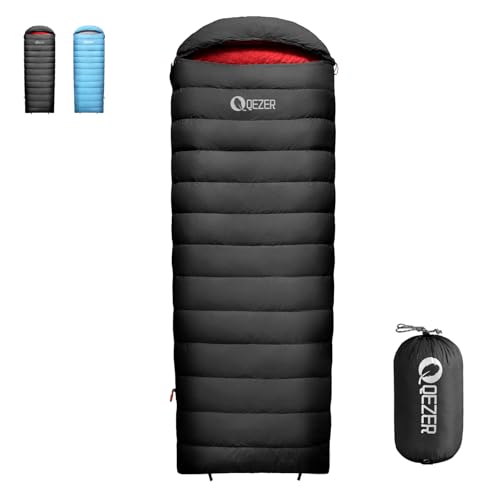
The QEZER Down Sleeping Bag delivers premium warmth-to-weight performance for ultralight backpackers who prioritize packability without sacrificing comfort. At just 1.54 pounds, you’ll get 0.66 pounds of 600 fill power duck down in a semi-rectangular design. The bag compresses to 10.6 x 5.5 inches while providing 82.7 x 31.5 inches of sleeping space.
You’ll stay warm down to 45°F with the comfort range hitting 59°F-68°F. The 400T 20D nylon shell resists tears and moisture while dense stitching prevents down migration. Double zippers block cold air infiltration, and chest insulation adds core warmth.
Customer ratings average 4.4 stars from 137 reviews. You’ll find this bag works best above 50°F for campers under six feet.
Best For: Ultralight backpackers and hikers under 6 feet tall who need a compact, warm sleeping bag for three-season camping in temperatures above 50°F.
Pros:
- Exceptional packability at just 1.54 pounds with compression to 10.6 x 5.5 inches
- Quality 600 fill power duck down provides excellent warmth-to-weight ratio
- Durable 400T 20D nylon construction with moisture resistance and tear protection
Cons:
- Limited to warmer weather use with 45°F temperature limit
- Size restrictions make it unsuitable for taller campers over 6 feet
- Some user concerns about outer fabric durability over extended use
Down Sleeping Bag 620FP, 3 Season Ultralight for Hiking & Camping

Backpackers who prioritize weight savings without sacrificing warmth will find exceptional value in this 620FP down sleeping bag designed for three-season adventures. At just 1.72 pounds, it compresses to 11×6.3 inches for efficient pack storage. The 14.1 ounces of RDS-certified 620 fill power down provides comfort temperatures from 44-60°F and handles limit conditions down to 35°F.
You’ll appreciate the generous 86.6×31.5-inch dimensions that accommodate adults and teenagers comfortably. The 400T 20D nylon shell delivers windproof protection while maintaining breathability and durability. Practical features include an internal valuables pocket and dual zippers for bag-to-bag connections, making it versatile for solo trips or shared adventures.
Best For: Ultralight backpackers and hikers who need a warm, compact sleeping bag for spring through fall camping trips where temperatures won’t drop below 35°F.
Pros:
- Excellent warmth-to-weight ratio at just 1.72 lbs with 620 fill power down insulation
- Compresses to a very small 11×6.3-inch packed size for efficient backpack storage
- Versatile features including internal pocket and dual zippers for connecting multiple bags
Cons:
- Limited to three-season use with 35°F lower limit, not suitable for winter camping
- Down insulation loses effectiveness when wet and takes longer to dry than synthetic alternatives
- Higher price point compared to synthetic fill sleeping bags of similar temperature ratings
Ultralight Down Sleeping Bag for Adults with Compression Sack

When weight becomes your primary concern on multi-day hiking adventures, the QEZER QDM260 Ultralight Down Sleeping Bag delivers exceptional performance at just 1.72 pounds. You’ll get 14.1 ounces of 600 fill power duck down that keeps you comfortable between 45°F and 61°F. The bag compresses to just 11.4 x 6.3 inches in its included nylon sack.
The mummy design features a wide trapezoidal bottom for improved comfort without sacrificing thermal efficiency. You’ll appreciate the 400T 20D tear-resistant nylon shell that provides waterproof and windproof protection. The zipper system allows coupling with another bag for two-person use when needed.
Best For: Ultralight backpackers and hikers who prioritize weight savings and need a compact 3-season sleeping bag for temperatures above freezing.
Pros:
- Exceptionally lightweight at 1.72 lbs with excellent compression to 11.4 x 6.3 inches for minimal pack space
- Quality 600 fill power duck down provides reliable warmth in the 45°F-61°F comfort range
- Versatile zipper system allows coupling with another bag for two-person use
Cons:
- Limited to warmer conditions with a minimum temperature rating of only 36°F
- Requires 3-4 hours of ventilation after unpacking due to extreme compression
- Higher price point compared to synthetic fill alternatives
Down Sleeping Bag for Adults with Compression Sack
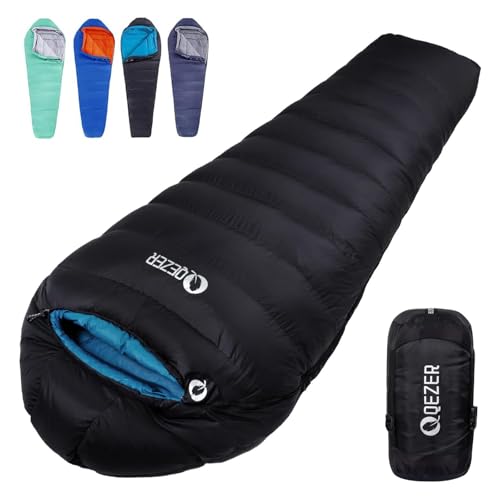
Why settle for heavy, bulky sleeping gear when weight matters most on extended backcountry trips? This down sleeping bag delivers exceptional warmth-to-weight performance at just 3.22 pounds. The 1.76 pounds of 600+ fill power duck down provides reliable insulation for temperatures ranging from 28°F to 45°F, with emergency ratings down to 18°F.
You’ll appreciate the mummy design’s thermal efficiency and trapezoidal foot box comfort. The 400T20D tear-resistant nylon shell prevents down migration while maintaining water resistance. Dual zipper configurations allow versatility for ventilation or coupling with another bag. When packed, it compresses to 14.2 x 7.5 inches—significantly smaller than synthetic alternatives. The included compression sack streamlines your packing system for multi-day adventures.
Best For: Backpackers and hikers who prioritize lightweight gear for extended backcountry trips in moderate to cold weather conditions.
Pros:
- Exceptional warmth-to-weight ratio at just 3.22 pounds with 600+ fill power duck down insulation
- Highly compressible design packs down to 14.2 x 7.5 inches, much smaller than synthetic alternatives
- Versatile dual zipper system allows for ventilation control and coupling with another bag for two-person use
Cons:
- Some users report zipper quality issues that may affect long-term durability
- Packing the bag back into the compression sack can be challenging and time-consuming
- Down insulation loses effectiveness when wet, requiring careful moisture management
Bessport Lightweight Sleeping Bag, 3 Season Waterproof for Outdoor Camping

The Bessport Lightweight Sleeping Bag delivers exceptional portability at just 1.98 pounds, making it an ideal choice for ultralight backpackers who prioritize weight savings without sacrificing comfort. You’ll appreciate its compact 13.7 x 5.9-inch packed size that won’t dominate your pack space. The 210T polyester exterior paired with soft faux silk lining provides durability while eliminating rustling noise during movement.
This three-season bag accommodates temperatures from 50°F to 85°F, with optimal comfort between 59°F and 68°F. The semi-rectangular design measures 63 x 26 inches, fitting users up to six feet tall. Its double-sided anti-snag zipper system allows foot ventilation and connects with another bag for couples. You can machine wash it, though air drying maintains the fill’s integrity and performance.
Best For: Ultralight backpackers and campers who need a lightweight, compact sleeping bag for spring, summer, and fall adventures in moderate temperature conditions.
Pros:
- Exceptional portability at just 1.98 pounds with compact 13.7 x 5.9-inch packed size
- Quiet faux silk lining eliminates rustling noise during movement for better sleep
- Versatile double-sided zipper system allows foot ventilation and connecting two bags together
Cons:
- Limited to warmer conditions with comfort range only down to 59°F
- Some customer concerns about zipper quality and durability
- Semi-rectangular shape fits users only up to 6 feet tall, limiting size options
Lightweight Waterproof Sleeping Bags for Adults Backpacking

Adult backpackers seeking reliable three-season protection will find waterproof sleeping bags essential for unpredictable weather conditions. The 190T nylon outer shell provides complete waterproof protection while maintaining breathability. You’ll appreciate the 3.3-pound weight and compression capability down to 7.9 inches for efficient packing.
This sleeping bag accommodates adults up to 5’11” with dimensions of 31.5″ x 86.6″. The polyester pongee lining and hollow cotton fill deliver comfort between 50℉-68℉. You can regulate temperature using the drawstring hood and foot zipper. The design functions as both sleeping bag and blanket, maximizing versatility for various outdoor scenarios.
Best For: Adult backpackers and campers up to 5’11” who need a versatile three-season sleeping bag for moderate weather conditions and prioritize lightweight, compressible gear.
Pros:
- Lightweight at 3.3 lbs with excellent compression down to 7.9 inches for efficient packing
- Versatile design functions as both sleeping bag and blanket with temperature regulation features
- Waterproof 190T nylon outer shell with breathable construction for weather protection
Cons:
- Limited to moderate temperatures (41℉-77℉) and not suitable for very cold weather camping
- Size restriction accommodates only adults up to 5’11” tall
- Hollow cotton fill may not provide the same warmth-to-weight ratio as down insulation
Teton 20F and 5F Degree Lightweight Mummy Sleeping Bag

Outdoor enthusiasts seeking a versatile sleeping solution for family camping and group adventures will find the Teton 20F and 5F Degree Lightweight Mummy Sleeping Bag delivers exceptional value through its double-wide design. You’ll get 87 x 63 x 3 inches of sleeping space at just 8.2 pounds. The PolarLite insulation provides thermal efficiency through body mapping technology and double-layer construction. Mummy hoods eliminate heat gaps around your head and face. Zipper draft tubes and insulated footboxes enhance comfort retention. You’ll stay comfortable down to +25°F with survival capability to +5°F. The included compression sack simplifies transport for backpacking adventures.
Best For: Families and outdoor enthusiasts who need a spacious, lightweight sleeping bag for camping, backpacking, and group adventures in cold weather conditions.
Pros:
- Double-wide mummy design provides generous sleeping space (87 x 63 inches) while maintaining thermal efficiency through body mapping technology
- Effective cold weather performance with comfort rating down to +25°F and survival capability to +5°F, enhanced by mummy hoods and insulated footboxes
- Lightweight at 8.2 pounds with included compression sack for easy transport, plus limited lifetime warranty and strong customer ratings (4.3/5 stars)
Cons:
- Cannot be machine washed, requiring more careful maintenance and cleaning procedures
- At 8.2 pounds, may be heavier than ultralight alternatives for solo backpackers prioritizing minimal weight
- Double-wide design may be unnecessarily large and bulky for individual users who don’t need the extra space
Naturehike Ultralight Down Sleeping Bag, 650FP, 3-4 Season

Weighing just 1.95 pounds in its medium size, Naturehike’s Ultralight Down Sleeping Bag delivers exceptional warmth-to-weight performance for three-season backpackers who refuse to compromise on comfort. The bag combines a mummy upper section for heat retention with a rectangular lower design that gives your feet freedom to move.
You’ll get 400 grams of 90% white goose down with either 750 or 550 fill power options. The 750FP version keeps you comfortable down to 41°F, while the 550FP variant works to 44.6°F. Both pack down to just 13.8″ x 6.3″ using the included compression sack.
The 400T 20D ripstop nylon shell balances durability with weight savings effectively.
Best For: Three-season backpackers and hikers who prioritize ultralight gear without sacrificing warmth and comfort in temperatures down to the upper 30s°F.
Pros:
- Exceptional warmth-to-weight ratio at just 1.95 pounds with 90% white goose down insulation
- Hybrid design combines mummy upper for heat retention with rectangular lower for foot movement freedom
- Ultra-compact packability (13.8″ x 6.3″) with included compression sack for easy transport
Cons:
- May not perform as advertised for true four-season use in harsh winter conditions
- Zipper cold spots reported by some users affecting overall warmth
- Potential compression damage during shipping that may affect insulation performance
Naturehike Lightweight Sleeping Bag with Compression Sack for 3 Season Camping

The Naturehike Lightweight Sleeping Bag delivers exceptional value for summer backpackers who prioritize weight savings over extreme cold weather protection. You’ll appreciate its 815-gram weight and compression system that packs down to Nalgene bottle size. The bag accommodates side sleepers up to 6’0″ and 175 pounds comfortably. However, you shouldn’t trust the manufacturer’s temperature ratings. Real-world performance shows effectiveness only above 60°F, with struggle points beginning around 55°F. You’ll need additional insulation for temperatures approaching 40°F. The waterproof exterior and quality zipper enhance durability. This bag excels for summer camping and warm-weather trekking above 10°C, making it ideal for ultralight enthusiasts operating in consistently warm conditions.
Best For: Summer backpackers and ultralight enthusiasts who need a compact, lightweight sleeping bag for warm weather camping above 60°F.
Pros:
- Extremely lightweight at 815 grams and compresses to Nalgene bottle size for excellent portability
- Comfortable for side sleepers up to 6’0″ and 175 pounds with good roominess and loft
- Quality construction with waterproof exterior and durable zipper at an excellent price point
Cons:
- Inadequate insulation below 55-60°F despite manufacturer’s temperature ratings
- Requires additional layers or insulation for temperatures approaching 40°F
- Limited to warm weather use only, making it unsuitable for true three-season camping
Ultralight Backpacking Sleeping Bag, Waterproof & Lightweight for Camping

Since you’ll encounter varying weather conditions on multi-day treks, the Nature Link Ultralight Backpacking Sleeping Bag delivers essential protection without compromising your pack weight. At 1.77 pounds, this rectangular sleeping bag compresses to just 11 inches in height using the included compression sack. The 20D ripstop nylon shell provides water resistance while the soft nylon lining maintains breathability. You’ll stay comfortable in temperatures between 50℉ and 63℉ with 160g/㎡ imitation silk cotton insulation. Dual zippers allow ventilation control, and you can connect two bags for double occupancy. The built-in hood features drawstring closure for additional warmth retention when needed.
Best For: Ultralight backpackers and campers who prioritize weight savings for warm weather trips and need a reliable sleeping solution that won’t weigh down their pack.
Pros:
- Exceptionally lightweight at 1.77 pounds with excellent compression capabilities for minimal pack space
- Durable 20D ripstop nylon construction with water-resistant properties and breathable soft lining
- Versatile dual zipper system for ventilation control plus option to connect two bags for couples
Cons:
- Limited to warm weather use only with temperature rating of 50-63℉, unsuitable for cold conditions
- Water-resistant rather than fully waterproof, providing inadequate protection in heavy rain
- Rectangular shape may be less thermally efficient than mummy-style bags for heat retention
Factors to Consider When Choosing an Ultralight Backpacking Sleeping Bag
I’ll guide you through five critical factors that determine whether an ultralight sleeping bag meets your backpacking needs. Each factor directly impacts your comfort, safety, and pack weight on the trail. Understanding these specifications before purchasing guarantees you select a bag that performs reliably in your specific camping conditions.
Weight and Portability
Weight stands as the primary consideration when selecting an ultralight backpacking sleeping bag, directly impacting your energy expenditure and overall hiking experience. I recommend targeting bags weighing between 1.5 to 3.3 pounds for ideal performance. This range provides excellent warmth-to-weight ratios without compromising durability.
Portability becomes equally important for extended treks. Look for bags that compress to 10-14 inches when packed. This compact size preserves valuable backpack space for essential gear. Compression sacks enhance this benefit considerably, enabling quick packing and unpacking during camp setup.
Materials like ripstop nylon deliver exceptional durability while maintaining minimal weight. These fabrics withstand harsh outdoor conditions without adding unnecessary bulk. The combination of lightweight construction and compact compression creates the perfect balance for serious backpackers who prioritize efficiency over luxury features.
Temperature Rating Range
Temperature ratings serve as your primary guide for matching sleeping bag performance to expected weather conditions, with comfort ranges spanning from 68°F for summer adventures down to 18°F for cold-weather expeditions. I recommend selecting bags rated 59°F to 68°F for warm-weather backpacking. Cold-climate trips require bags rated as low as 18°F for adequate protection.
Fill power directly impacts temperature performance. Higher ratings from 600FP to 750FP deliver superior insulation without weight penalties. This measurement indicates how much space one ounce of down occupies in cubic inches.
Personal heat retention varies considerably between individuals. You might feel cold at manufacturer-suggested temperatures, while others remain comfortable. Consider your typical sleeping patterns and body heat production when selecting temperature ratings for ideal comfort.
Fill Power Quality
While temperature ratings tell you when a sleeping bag performs, fill power reveals how efficiently it delivers that performance through superior down quality and compression characteristics. I recommend focusing on bags with 750+ fill power for ultralight backpacking. Higher fill power means fewer down clusters needed for equivalent insulation, reducing overall weight.
A 700-fill bag requires more down than an 800-fill bag to achieve identical warmth. This directly impacts your pack weight and compressed size. Premium 850+ fill power down compresses to remarkably small volumes while maintaining excellent loft recovery.
Look for RDS-certified down to guarantee ethical sourcing without compromising performance. Consider both fill weight and fill power together—a bag with 12 ounces of 800-fill down outperforms one with 10 ounces of 650-fill down in warmth-to-weight ratio.
Pack Size Compression
Premium fill power means nothing if your sleeping bag consumes half your pack space. Pack size compression directly impacts your hiking efficiency and gear management capabilities.
Quality ultralight sleeping bags compress to remarkably small dimensions. I’ve tested models that shrink to 10 x 5.5 inches, while others measure 11 x 6.3 inches when fully compressed. These specifications matter when you’re calculating pack volume for multi-day expeditions.
Advanced materials enable superior compression ratios without compromising insulation performance. Well-designed ultralight bags compress to approximately half the volume of traditional polyester models. This compression advantage becomes critical when you’re carrying additional gear like cooking equipment or emergency supplies.
Weight correlates with compressibility—bags ranging from 1.54 to 3.3 pounds typically offer the best compression-to-warmth ratios. Review manufacturer compression specifications carefully, as different designs accommodate varying storage preferences.
Material Durability Features
Although ultralight sleeping bags prioritize weight reduction, durability can’t be sacrificed for backcountry reliability. I recommend focusing on high-density nylon construction, particularly 400T 20D fabric specifications. This material delivers exceptional tear resistance while maintaining minimal weight penalties.
The outer shell’s water-resistant treatment prevents moisture infiltration that compromises insulation performance. Dense stitching prevents down migration and maintains structural integrity over extended use. You’ll find that quality construction methods directly impact longevity—reinforced seams and bartacked stress points resist failure during compression cycles.
Down insulation with 600-750 fill power provides ideal warmth-to-weight ratios while resisting compression damage. These materials work together like armor protecting your sleep system. Proper material selection guarantees your sleeping bag withstands repeated packing, unpacking, and environmental exposure without performance degradation.
Shape and Comfort
Beyond material quality, sleeping bag geometry directly impacts your comfort and thermal efficiency on the trail. Mummy-shaped bags deliver superior warmth-to-weight ratios through their tapered foot design, reducing dead air space that your body must heat. However, this snug fit restricts movement and feels claustrophobic for many users.
Semi-rectangular shapes offer greater freedom for side sleepers while maintaining reasonable thermal performance. Look for bags with trapezoidal foot boxes rather than standard narrow designs—they allow natural foot positioning without compromising insulation.
Width becomes critical for comfort during extended trips. Ultralight rectangular options accommodate various sleeping positions but sacrifice some thermal efficiency. Consider your height carefully; bags rated for users up to 6 feet provide better proportional fit for taller backpackers, preventing cold spots at shoulders and feet.
Frequently Asked Questions
How Do I Properly Wash and Dry My Down Sleeping Bag?
I’ll walk you through washing your down sleeping bag properly. Use a front-loading machine on gentle cycle with specialized down detergent. Never use fabric softener or bleach. Add tennis balls during the rinse cycle to prevent clumping. For drying, use low heat with clean tennis balls, checking every 30 minutes. Expect 3-4 hours total drying time to restore full loft.
Can Ultralight Sleeping Bags Be Repaired if They Get Torn or Damaged?
Yes, I can repair most ultralight sleeping bag damage. Small tears require fabric patches and seam sealer. Down fill escapes through holes, so I’ll patch immediately. Zipper failures need professional repair or replacement. I’ll use repair tape for field fixes, then permanent patches at home. Synthetic fill bags handle repairs better than down. Major tears exceeding two inches typically require professional restoration or replacement.
What’s the Difference Between Regular and Long Sleeping Bag Sizes?
Regular sleeping bags typically measure 72-78 inches in length and accommodate most people up to 6 feet tall. Long versions extend to 84 inches, fitting users up to 6’6″. I recommend choosing long if you’re over 5’10” or prefer extra foot room. The additional length adds roughly 2-4 ounces to ultralight models. Width remains consistent between sizes, but longer bags provide better thermal efficiency for taller users.
How Often Should I Replace My Ultralight Backpacking Sleeping Bag?
I recommend replacing your ultralight sleeping bag every 300-500 nights of use or 8-10 years, whichever comes first. You’ll notice decreased loft in down fill, reduced compression ratios, and compromised insulation performance. Shell fabric develops wear points and loses DWR coating effectiveness. Temperature ratings drop 5-10°F as materials degrade. Replace immediately if you experience cold spots, zipper failures, or significant baffle separation during use.
Are There Sleeping Bag Liners That Work Well With Ultralight Bags?
I recommend silk and merino wool liners for ultralight sleeping bags. Silk liners add 5-10°F warmth while weighing just 2-4 ounces. Sea to Summit’s Thermolite Reactor adds 14°F for 4.4 ounces. Merino wool liners provide moisture management but weigh more at 6-8 ounces. Choose liners with tapered cuts to match your bag’s profile and prevent bunching.
On a final note
I’ve covered eight top-performing ultralight sleeping bags that’ll serve you well on the trail. Each model offers specific weight-to-warmth ratios and compression capabilities that matter when you’re counting ounces. Consider your typical camping temperatures, pack space, and budget when making your selection. The right ultralight sleeping bag becomes essential gear that you’ll rely on for countless adventures. Choose based on fill power, weight, and temperature ratings that match your hiking style.

